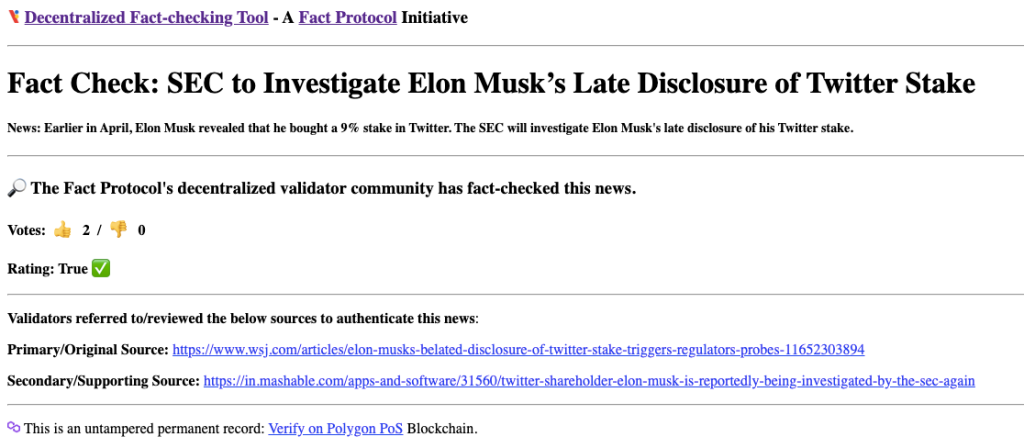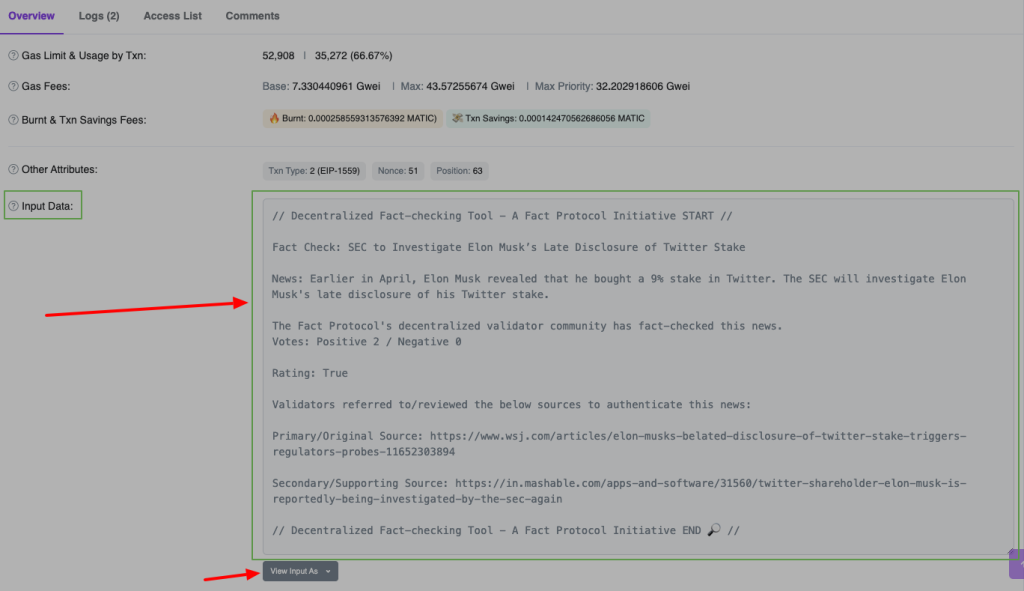
Blockchain technology has the potential to revolutionize the way we consume and disseminate information, including news. One of the major benefits of using blockchain in the context of news is its ability to help detect and combat the spread of fake news.
Fake news, also known as misinformation or disinformation, refers to false or misleading information presented as if it were real news. It has become a significant problem in today’s digital age, as the internet and social media have made it easier for fake news to spread rapidly and reach a wide audience. Fake news can have serious consequences, including undermining trust in institutions and causing harm to individuals and communities.
One way that blockchain can help combat fake news is through the use of cryptographic techniques to ensure the authenticity and integrity of news content. Cryptography is the practice of secure communication, and it involves the use of mathematical algorithms to encode and decode information. Blockchain uses cryptographic techniques to create a secure, decentralized ledger that records transactions in a way that is transparent, verifiable, and resistant to tampering.
Using Blockchain for Fake News Detection
The detection of fake news using blockchain is a relatively new concept, but one that has gained significant attention in recent years. Blockchain technology has the potential to revolutionize the way we identify and combat fake news, misinformation, and disinformation. Blockchain technology can facilitate the verification of news sources, as it allows for the creation of a trustless system where information can be cross-referenced and authenticated by multiple parties.
By utilizing blockchain technology, it may be possible to create a more reliable and transparent news ecosystem, where consumers can trust the accuracy and veracity of the information they are receiving.
Blockchain technology offers several benefits that can help combat fake news, including immutability, transparency, decentralization, incentives, and collaboration. Let’s discuss these benefits:
Immutability
Immutability is one of the most significant benefits of using blockchain technology in combating fake news. By design, a blockchain is a distributed ledger that cannot be altered or deleted once a transaction is recorded. This means that once news or information is recorded on a blockchain, it becomes a permanent and tamper-proof record that can be verified and authenticated by anyone, at any time. This information can be used for future reference and detect fake news, misinformation, and, disinformation as the blockchain ledger it can play the role of a permanent archive which is better than other types of archives.


In the context of fake news, immutability can help to prevent the alteration or deletion of news and information by malicious actors, ensuring that the public has access to accurate and reliable information. Moreover, immutability can help to establish a clear and transparent record of the source and origin of news and information, making it easier to identify and track the spread of fake news. Overall, the immutability of blockchain technology can help to enhance transparency and accountability in the news and information ecosystem, contributing to a more trustworthy and reliable media environment.
Example: Let’s say a news organization publishes an article that contains factual errors or misinformation. If the article is recorded on a blockchain, the errors cannot be altered or deleted without leaving a trace. This allows for transparent and accountable fact-checking, as anyone can verify and authenticate the original information and subsequent corrections.
Transparency & Provenance
Transparency is another significant benefit of using blockchain technology in combating fake news. The transparent nature of blockchain technology allows for a decentralized network of nodes to verify the authenticity of news and information. This means that the public can see and track the source and origin of news and information, which helps to establish trust and confidence in the information presented. Furthermore, the transparency provided by blockchain technology can help to reduce the spread of misinformation by making it easier for users to identify and verify accurate information.
In addition, blockchain technology can help to establish a clear and transparent record of the origin and history (provenance) and ownership of news and information. This record can be verified by anyone with access to the blockchain and web3 systems such as IPFS or any other decentralized storage protocol the fact-checkers uses to record the data, ensuring that the news content has not been altered or tampered with. Overall, the transparency provided by blockchain technology can help to build a more trustworthy and reliable media environment by promoting the dissemination of accurate and reliable news and information.
Example: With the help of blockchain, political campaigns could provide transparent and tamper-proof records of their funding sources and spending activities. This could help to reduce the potential for political corruption and the spread of false information about campaign finances. By using blockchain technology, political campaigns could build trust with the public and promote transparency and accountability in the political process.
Another Example: Blockchain technology can help to establish the provenance of news and information by creating a tamper-proof record of the entire chain of custody of a news item. Let’s say a news organization could use blockchain technology to record the entire process of collecting, verifying, and publishing a news story, including information on sources, interviews, and fact-checking. By recording this information on the blockchain, the provenance of the news story can be established and verified by anyone at any time, ensuring that the news story is accurate and reliable.
Decentralization
Decentralization is another key benefit of using blockchain technology to combat fake news. In a decentralized system, there is no central authority that controls the information or decides what is true or false. Instead, information is verified and authenticated by a network of nodes that work together to maintain the integrity of the system. This means that no single entity can manipulate or alter the information, which helps to prevent the spread of fake news.

Furthermore, decentralization can help to increase the resilience and security of the news and information ecosystem. Since the information is distributed across a network of nodes, there is no single point of failure that can be exploited by malicious actors. This means that even if some nodes are compromised, the rest of the network can continue to operate and verify the authenticity of the information. Simply put, the decentralization provided by blockchain technology can help to increase trust and confidence in the news and information ecosystem, contributing to a more secure and resilient media environment.
Incentives
In the case of combating fake news, incentives can be provided to participants who verify the authenticity of the information or report instances of fake news. These incentives can take many forms, such as monetary rewards or tokens that can be exchanged for goods or services or even exchange these tokens for other tokens or coins at any exchange. By providing incentives, blockchain systems can help to encourage more active participation and engagement in the fight against fake news, ultimately leading to a more robust and effective system.
Furthermore, incentives can also help to promote greater accountability and responsibility among participants in the system. Since participants are incentivized to act in the best interests of the system, they are more likely to take their role as verifiers or reporters seriously, which can help to reduce the spread of fake news. Additionally, by providing a transparent and auditable record of the actions of participants, incentives can help to ensure that participants are held accountable for their actions and that the system remains fair and just. In essence, the incentives provided by blockchain technology can help to create a more collaborative and accountable environment, contributing to a more effective fight against fake news.
Collaboration
Collaboration is another key benefit of using blockchain technology to combat fake news. Due to the decentralized nature of blockchain systems, multiple participants can contribute to the system and work together towards a common goal. In the context of combating fake news, this means that a diverse group of individuals, organizations, and institutions can work collaboratively to identify and fact-check the information, reducing the spread of fake news. Collaboration also allows for a more inclusive and diverse range of perspectives, which can help to reduce bias and ensure that the system is fair and impartial.
Also, by leveraging the expertise and knowledge of a diverse range of participants, the system can be designed to be more adaptable and responsive to new threats and challenges. This can include the development of new tools and technologies for identifying and verifying information, as well as the creation of more sophisticated algorithms and machine/deep learning models. By working collaboratively, participants can help to ensure that the system remains effective and relevant, even as the landscape of fake news continues to evolve.
Are Smart Contracts Useful in Fight Against Fake News?
A smart contract is a self-executing contract that is stored on a blockchain network. It is a computer program that automatically enforces the rules and conditions of the contract and executes the terms of the agreement when certain predefined conditions are met. Smart contracts are secure, tamper-proof, and transparent, as they are recorded on a distributed ledger, which is a public and immutable database. They are increasingly being used in various industries and applications, including finance, real estate, supply chain management, and more.
In terms of mitigating fake news, as explained above, Smart contracts can be used to enforce rules and standards for the sharing and dissemination of information. Smart contracts can also be used to incentivize participants (discussed above) to contribute to the system and ensure that they are held accountable for their actions.
For example, a smart contract could be created to reward participants for identifying and reporting fake news, or for contributing to the verification process. The smart contract would automatically distribute rewards to participants based on their contributions, providing a powerful incentive for individuals and organizations to work together to combat fake news. By leveraging the power of smart contracts, it is possible to create a more secure, transparent, scalable, and efficient system for combating fake news that is resistant to manipulation and fraud.
Fact Protocol – A Decentralized Fact-checking System
Fact Protocol employs blockchain technology to combat fake news. Fact Protocol is a decentralized fact-checking system that leverages distributed communities to validate news using 2FA (two-factor approach), with the first factor being a news registrar, also known as an “NR,” who is a fact-checker. The NR will register the news by fact-checking all of the claims in that specific news, cross-checking with credible sources and/or original (primary) sources, and attaching the results for validation.
The second aspect is the news validator, also known as “NV,” who is a validator or, in other words, someone who fact-checks the fact-checkers. Now, an NV will authenticate the news registered by NR using the sources they provided and if necessary they will also perform their own research to identify and validate the sources. Fact Protocol aims to use this 2FA process to reduce bias and penalize bad actors, and also to increase trust in information.
Fact Protocol believes that blockchain technology has the potential to be an effective tool in combating fake news. Blockchain can help ensure that the public has access to accurate and reliable information by employing cryptographic techniques and processes such as 2FA to ensure the validity and integrity of news content and smart contracts to semi-automate the verification and validation process.